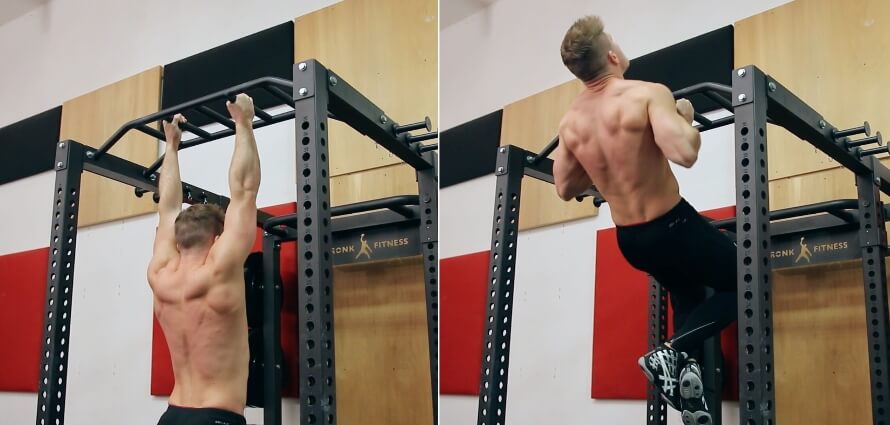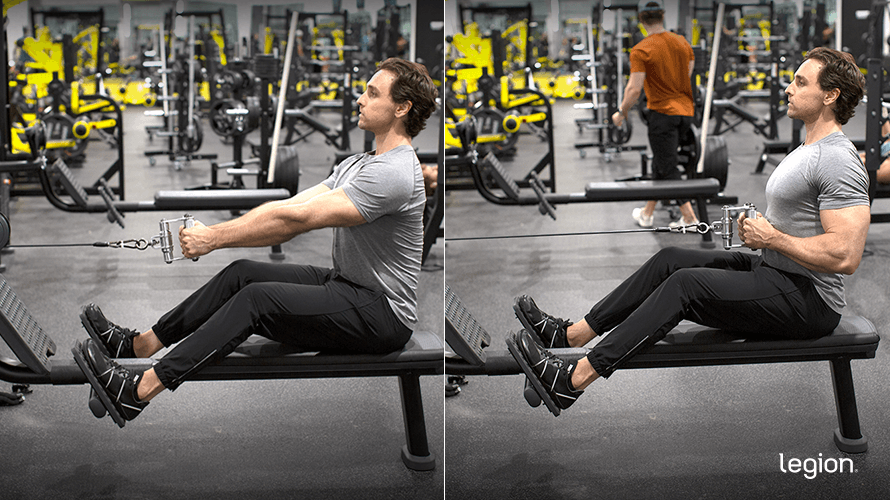The close-grip lat pulldown is a back exercise that primarily trains widest backor “rat”.
You can perform this movement on a lat pull-down machine using a V-bar attachment, which allows for a narrow hand position and a neutral grip (palms facing each other). It’s great for building back muscles and strength, easy to learn, and perfect for people with lower back problems.
In this expert guide, you’ll learn about proper close-grip lat pulldown form, the benefits of close-grip lat pulldowns, common mistakes to avoid, the best variations and alternatives to incorporate into your routine, and more.
How to Perform Close Grip Lat Pulldowns
To perform a narrow high dropdown, follow these steps:
1. Settings
Attach the V-bar to the lat pulley pulley and choose the right weight to maintain correct form and form Scope of activities throughout the exercise.
Sit on a high-back pull-down machine seat and adjust your knee pads so they lock your lower body in place, then slide your thighs out and stand up, grabbing the V-bar with both hands.
Keeping your grip on the bar and your arms straight, sit down and let your body weight pull the bar down. Push your thighs under your knee pads and place your feet flat on the floor.
2. pull
Sit with your chest high, Arch your lower back slightly to help engage your lats.
Without swinging your torso backward, pull the handle toward your chest until it’s under your chin (or touch your chest if you want to make the exercise more difficult). As you pull the bar down, squeeze your shoulder blades together and pull down.
A good one”hint” is for Imagine pulling your elbows to the floor.
3. rise
Reverse movement and return to starting position. This reflects what you are doing during the pull.
When you put it all together, it should look like this:
Benefits of Close Grip Lat Pulldowns
Let’s explore some of the key benefits of the narrow-gap lat pulldown.
defender training
Grip lat pulldowns are an excellent exercise train Almost all muscles of the back, including latissimus dorsirhomboid, middle trapezius and posterior deltoid muscle.
Training these muscle groups simultaneously is ideal for gaining balanced size and strength in the back of the body.
it also trains biceps, Shoulder, forearm, triceps, chest musclesand abdominal muscles To a lesser extent.
Easy to learn for beginners
When most weightlifters think of “vertical pull” exercises (exercises that involve pulling something overhead toward the body), they think of pull-ups and pull-ups.
While these are excellent back exercises, for beginner Or those who are overweight, as they may not have the strength to complete a single rep.
The close-grip lat pulldown is a helpful solution because it works similar muscles but allows you to adjust the weight and gradually build strength.
Reduce waist pressure
Close-grip pulldowns minimize stress on the body lower backenhance the overall comfort during exercise.
Unlike exercises such as bend overGripping lat pulldowns puts pressure on your spine as you bend over, keeping you in an upright position and reducing lower back discomfort.
Improve posture
Strengthening your back muscles through exercises such as grip pulldowns can help improve posture by strengthening the muscles that hold your shoulders back and prevent over-rounding of your upper back.
Common Mistakes to Avoid When Performing Close Grip Lat Pulldowns
While the close-grip lat pulldown is an effective exercise, it’s crucial to understand common mistakes that can hinder your progress and increase your risk of failure. Injuried. Here are some common mistakes to avoid:
Take advantage of momentum
Generating momentum by “whipping” your upper body backwards when you pull heavy weights reduces back involvement and shifts the emphasis to other muscle groups. If developing your back is your priority, this is the way to go. is a bad thing.
Avoid this by keeping your back still, upper body tension, and core stability throughout the entire range of motion.
pulled too low
Placing the barbell below your upper chest may strain your shoulder joints and reduce the effectiveness of the exercise. Maintaining proper range of motion, lower the barbell below your chin or engage your upper pecs. This properly engages your back muscles and prevents shoulder discomfort.
Pull with your biceps
It’s easy to over-rely on your biceps instead of your back when performing close-grip pulldowns. However, doing so will deprive your target muscles of muscle and strength gains.
To minimize bicep involvement, imagine pulling your elbows to the floor. This maximizes your lat contribution while reducing bicep involvement.
The Best Close Grip Lat Pulldown Variations and Alternatives
While the close-grip lat pulldown is an effective exercise, incorporating variations and alternatives can add variety to your routine and target your back muscles in different ways. Here are some of the best narrow-gauge lat pulldown variations and alternatives:
1. Single-arm high pulldown

The one-arm lat pulldown is a great variation that focuses on one side of your body at a time to help you find and fix muscle imbalance.
To perform a one-arm lat pulldown, attach the D-handle to the top pulley of the lat pulldown machine. Grasp the handle with one hand and pull it toward your chest, mimicking the motion of a traditional lat pulldown.
This exercise also works the core muscles, especially the obliques, as they help stabilize the body during movement.
2. Mid-grip pull-ups

The mid-grip pull-up is a great alternative to the close-grip lat pull-down, targeting the same muscles but without the need for a lat pull-down machine. You can perform this variation using a set of parallel bars or a neutral-grip pull-up bar.
3. High pull-down

regular Latitude drop down Trains your back similarly to the close-grip lat pulldown, although it may be slightly better at training the lats, but less effective at targeting the rear delts.
4. Cable Rowing

this Cable row A great alternative to the close-grip lat pulldown, which involves using a neutral grip to pull the weight horizontally toward your abs while keeping your elbows close to your sides.Similar to the close-grip pulldown, the rope row train The height of your mid-back, especially your lats.
5. One-Arm Dumbbell Row

this One-arm dumbbell row is another great alternative to the close-grip lat pulldown that works all the muscles of the mid-back, especially the lats, traps, and rhomboids. To perform this exercise, hold a dumbbell in one hand, place your other knee and hand on the bench for support, and row the dumbbell out to your side while keeping your back straight.
A significant advantage of the one-arm dumbbell row is that it requires very little equipment, making it a useful alternative for those who don’t have access to a lat pull-down machine.
Tighten your muscles with high pull-downs
Below is a chart of the major muscles worked by the tight-grip lat pulldown:

Sets and reps for close-grip lat pulldowns
The close-grip pulldown involves several major muscle groups simultaneously, so as long as you use good form, you can use heavier loads without compromising safety.
Doing 3 sets of 4 to 6 or 6 to 8 repetitions works well for most men, while 3 sets of 6 to 8 or 8 to 10 repetitions is better for women.
FAQ #1: What is the difference between a wide-grip lat pulldown and a narrow-grip lat pulldown?
The wide-grip pull-down is better for training your lats, while the narrow-grip pull-down is better for training your rear delts. The narrow-grip version also works the pecs and triceps more than the wide-grip version, although neither is a “chest” or “triceps” exercise.
However, these differences are minimal and likely have little effect on long-term muscle growth.
FAQ #2: Which grip is best for lat pulldowns?
There is no “best” grip for lat pulldowns. For most people, the best solution is to regularly experiment with grip width and direction.
this way possible reason It results in more balanced and complete growth than just one or two grips, and can help you avoid repetitive strain injuries that can occur when you perform the same exercise for a long time.
FAQ #3: Will lat pull-downs help my pull-ups?
Yes, lat pull-down exercises can help improve your pull-up strength.
Lat pulldowns target the same muscles used in pull-ups, such as your lats and biceps. By strengthening these muscles with lat pull-down exercises, you can improve your pull-up abilities.
In other words, strength yes “Be specific.” In other words, the best way to improve your pull-ups is to do pull-ups.
+ scientific references
- Signorile, Joseph F., et al. “A comparative electromyographic study of muscle utilization patterns using different hand positions during the lat pulldown.” Journal of Strength and Conditioning Research, vol. 16. No. 4, 1 November 2002, pp. 539-546, pubmed.ncbi.nlm.nih.gov/12423182/. Date viewed: August 2, 2021.
- Handa, Toru et al. Comparative electromyographic study of the biceps brachii, latissimus dorsi, and trapezius muscles during five pulling exercises. April 2005, https://doi.org/10.7600/jspfsm.54.159.
- Barakat, Christopher, et al. “Effects of Different Glenohumeral Joint Angles on Acute Volume Loading, Muscle Activation, Swelling, and Biceps Echo Intensity in Resistance Trainers.” Physical Education, Vol. 7. No. September 4, 2019, page 9. 204, https://doi.org/10.3390/sports7090204.
- Costa, Bruna Daniela de Vasconcelos, et al. “Do different resistance training exercises for the same muscle group lead to non-uniform hypertrophy?” International Journal of Sports Medicine, vol. 42. No. 09, 13 January 2021, pp. 803–811, https://doi.org/10.1055/a-1308-3674.
- Stone, Michael H., et al. “Training Specificity in Athletes: Emphasis on Strength-Strength Training: A Narrative Review.” Journal of Functional Morphology and Kinesiology, Vol. 7. No. 16 Nov 2022, Page 4, 102, mdpi-res.com/d_attachment/jfmk/jfmk-07-00102/article_deploy/jfmk-07-00102.pdf?version=1668586112, https://doi.org /10.3390/jfmk2.
